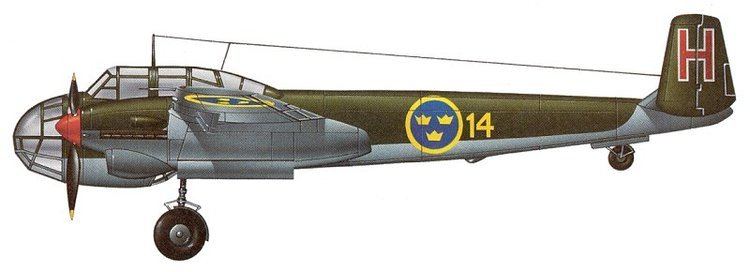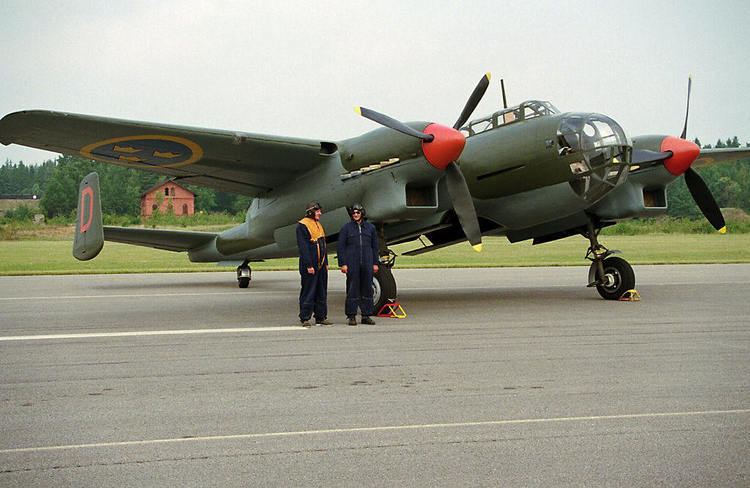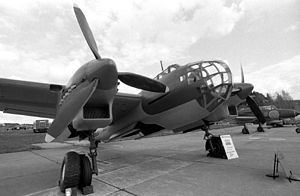Top speed 575 km/h Length 13 m Manufacturer Saab Group | Wingspan 17 m Retired 1959 | |
 | ||
Tsf 2 saab 18 tankbuster
The SAAB 18 was a twin-engine bomber and reconnaissance aircraft, designed and built for use by the Swedish Air Force by Svenska Aeroplan AB (SAAB) in response to a 1938 design competition. Due to delays, it did not enter service until 1944, but quickly became the standard Swedish bomber aircraft. Serving in the bomber, reconnaissance and ground-attack roles, it also assisted in the development of ejection seats and air-to-surface guided missiles until its replacement by the Saab Lansen in the late 1950s.
Contents
- Tsf 2 saab 18 tankbuster
- B 18 saab 18
- Design and development
- Operational history
- Survivors
- Variants
- Operators
- Specifications B 18B
- References

B 18 saab 18
Design and development

Intended as a replacement for the Junkers Ju 86 in service with the Swedish Air Force, the requirement that led to the Saab 18 called for a three-seat fast reconnaissance aircraft.

AB Svenska Järnvägsverkstädernas Aeroplanavdelning (ASJA), SAAB, and AB Götaverken (GV) submitted designs for consideration by the Swedish Air Force. GV's GV8 appeared to be the best suited to the requirement; however, its cost and the departure of their chief designer resulted in SAAB — the company having merged with ASJA in the meantime — being awarded a contract for development of their design.

As a number of Americans were on the design staff of SAAB and ASJA, the Saab 18's design shared some similarities with American designs. The outbreak of World War II in 1939 led to a change of priorities by the Swedish Air Force, and production of the Saab 17 was accelerated, at the expense of work on the Saab 18, which, along with a change of requirements that added the role of medium bomber to the specification, resulted in the first flight of the aircraft being delayed until 19 June 1942.

Manned by a crew of three — a pilot and navigator under a glazed, offset canopy, and a bombardier in the nose — the Saab 18 prototype was a mid-wing monoplane with twin vertical stabilisers, and was powered by two Pratt & Whitney R-1830 Twin Wasp radial engines. Armament consisted of three 13.2-millimetre (0.52 in) machine guns, one fixed firing forwards and controlled by the pilot, the others being in flexible defensive mounts for use by the navigator and bombardier. Up to 1,000 kilograms (2,200 lb) of bombs could be carried in an internal bay, while up to eight 50-kilogram (110 lb) bombs could be carried on underwing hardpoints.

Flight testing showed that the aircraft was underpowered. However, as there was no immediate prospect for the acquisition of more powerful engines, the Saab 18 was ordered into production in both bomber (B 18A) and reconnaissance (S 18A) versions.
Operational history
The B 18A entered service in June 1944, and quickly became Sweden's standard medium bomber aircraft. As license-built Daimler-Benz DB 605 liquid-cooled, inline engines had become available, they were incorporated into the improved Saab 18B, which first flew on 10 July 1944.
Ordered into production as the B 18B dive bomber, the 18B design was further developed into the T 18B, which was planned to be a torpedo bomber variant. Due to difficulties with the torpedoes, however, the T 18B was instead developed into a heavy ground-attack aircraft, mounting a Bofors 57-millimetre (2.2 in) cannon under the nose.
By the late 1940s, the third crewmember's position had been eliminated, reducing the crew of the aircraft to two; the provision of air-to-ground rockets and improved bombsights had removed the requirement for a bombardier. By this time the Saab 18 had established a reputation for suffering a serious rate of attrition, and this led to the decision to outfit all of the surviving aircraft with ejection seats for the pilot and navigator/gunner.
Production of the Saab 18 totaled 245 examples, with the last T 18B being delivered in 1948. Used in trials of early Swedish air-to-surface missiles, the Saab 18 remained one of Sweden's frontline ground attack and reconnaissance platforms until the late 1950s, when it was replaced by the jet-powered, swept wing Saab 32 Lansen, the B 18B and T 18B being replaced by the A 32A in 1958, with the last S 18As being replaced by S 32Cs in 1959.
Survivors
Only a single example of the Saab 18 survives today: a B 18B, coded Red David. It is part of the collection of the Flygvapenmuseum, the Swedish Air Force Museum near Linköping in Sweden. One of a group of eight aircraft lost in a snowstorm in 1946, it was recovered and restored in 1979.
Variants
Operators
Specifications (B 18B)
Data from
General characteristics
Performance
Armament
